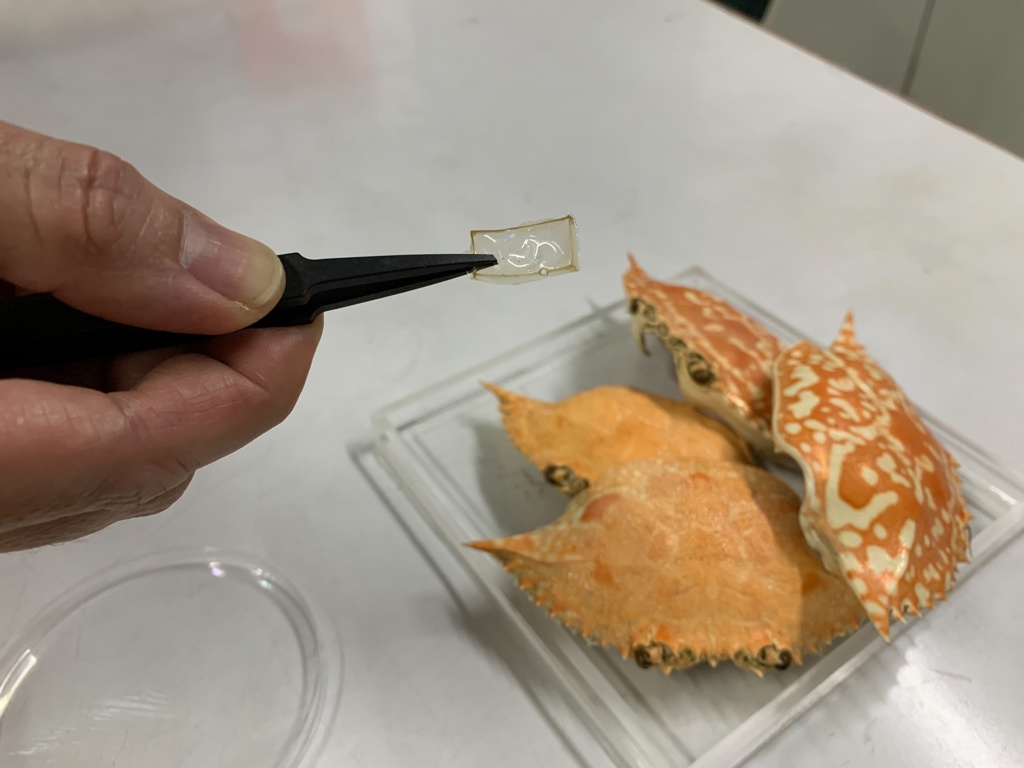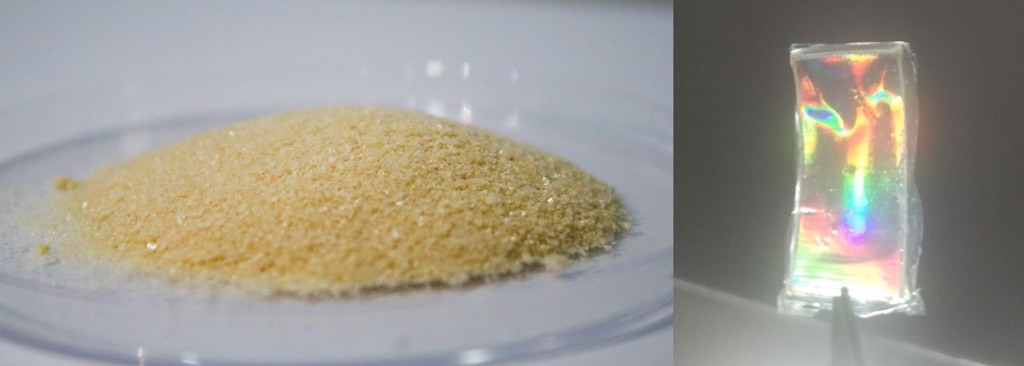Researchers make biodegradable optical components from crab shells
About Optica
22 March 2023
Researchers make biodegradable optical components from crab shells
Diffraction gratings made from seafood waste could enable disposable spectrometers that don’t harm the environment

Caption: Researchers developed a process to turn crab shells into a bioplastic that can be used to make optical components known as diffraction gratings (in the tweezers).
Credit: Raphael A. Guerrero, Ateneo de Manila University
WASHINGTON — Researchers have developed a process to turn crab shells into a bioplastic that can be used to make optical components known as diffraction gratings. The resulting lightweight, inexpensive gratings are biodegradable and could enable portable spectrometers that are also disposable.
“The Philippines is known for delicious seafood, but this industry is also a source of large amounts of solid waste such as discarded crab shells,” said research team leader Raphael A. Guerrero, from Ateneo de Manila University in the Philippines. “We wanted to find an alternative use for crab shell waste, and decided to find out if chitosan from crab shells could be used as a biodegradable replacement for silicone, which we had previously used in our lab to make diffraction gratings.”
In the Optica Publishing Group journal Applied Optics, the researchers showed that the chitosan-based bioplastic can be used to make diffraction gratings that work just like commercially available ones.
“Gratings made of chitosan are biodegradable and environmentally friendly while also being very inexpensive since crab shells are generally considered waste,” said Guerrero. “By showing that useful optical components can be made from materials typically considered waste, we hope to help improve sustainability in optical manufacturing and reduce the amount of seafood waste that requires disposal.”
Turning crab shells into optics
The researchers decided to explore chitosan due to its promising optical properties. In purified form as a solution, chitosan is transparent and can be molded much like silicone while having a higher refractive index, which is important for certain applications.

Caption: The researchers ground dried crab shells into a powder (left) and then used a chemical process to create a solution suitable for making a diffraction grating (right).
Credit: Raphael A. Guerrero, Ateneo de Manila University
To extract chitosan from crab shells, the researchers washed shells that were collected from a local processing plant and dried them in an oven. The shells were then crushed into a powder and turned into a chitosan solution using a chemical process.
The researchers made gratings from the chitosan solution using soft lithography, a replication process that uses a silicone mold to copy the nanoscale surface features of an object. This involved preparing a silicone cast of a commercially available diffraction grating and then pouring the chitosan solution into it. When the solution hardened, it created a replica of the commercial grating.
“Unlike subtractive methods such as laser etching, our soft lithography technique does not create chitosan waste,” said Guerrero. “We can also modify the physical properties of chitosan to better fit a particular need by changing the chemical steps used.”
A diffraction grating has a surface with thousands of microscopic grooves that can split white light into its component colors. When white light was used to illuminate a chitosan grating, the researchers could clearly see the expected rainbow pattern. They also used atomic force microscopy to confirm that the spacing between the grooves of the chitosan grating corresponded to those of the original commercial grating. Finally, tests of the chitosan diffraction gratings with a laser beam produced the correct diffraction patterns.
Single-use spectrometers
“Diffraction gratings are the primary components of spectrometers, instruments used in a variety of industrial and scientific applications to analyze the way that light interacts with a sample to determine its chemical composition,” said Guerrero. “Conventional gratings are typically made of heavy materials such as glass, but gratings made of chitosan could be used to make lighter and less expensive spectrometers.”
The researchers have not yet tested the durability of the chitosan gratings but say that they would be appropriate for disposable spectrometers used for fieldwork. Such an instrument could be used to analyze water pollution in a stream or a food or drug product on the factory floor, for example. Since the material is biodegradable, devices made from chitosan would have minimal impact on the environment. They are also working to improve the power efficiency of the chitosan gratings to make them practical for real-world applications.
“For communities engaged in the crab industry, particularly in the Philippines, our findings add value to their seafood product, since even the waste components could find use in optical manufacturing,” said Guerrero. “With proper collaboration between businesses and the local government, chitosan extracted from crab shells could lead to increased income and a better quality of life for crab fishermen and their families.”
Paper: E. G. Gumayan, I. K. D. Dimzon, R. A. Guerrero, “Chitosan from crab shell waste for soft lithography of bioplastic diffraction gratings,” Applied Optics, vol. 62, issue 10 pp. 2487-2492 (2023).
DOI: https://doi.org/10.1364/AO.483336
About Optica Publishing Group
Optica Publishing Group is a division of the society, Optica, Advancing Optics and Photonics Worldwide. It publishes the largest collection of peer-reviewed and most-cited content in optics and photonics, including 18 prestigious journals, the society’s flagship member magazine, and papers and videos from more than 835 conferences. With over 400,000 journal articles, conference papers and videos to search, discover and access, our publications portfolio represents the full range of research in the field from around the globe.
About Applied Optics
Applied Optics publishes in-depth peer-reviewed content about applications-centered research in optics. These articles cover research in optical technology, photonics, lasers, information processing, sensing, and environmental optics. Optica Publishing Group publishes Applied Optics three times per month and oversees Editor-in-Chief Gisele Bennett, MEPSS LLC. For more information, visit Applied Optics.
Media Contact
